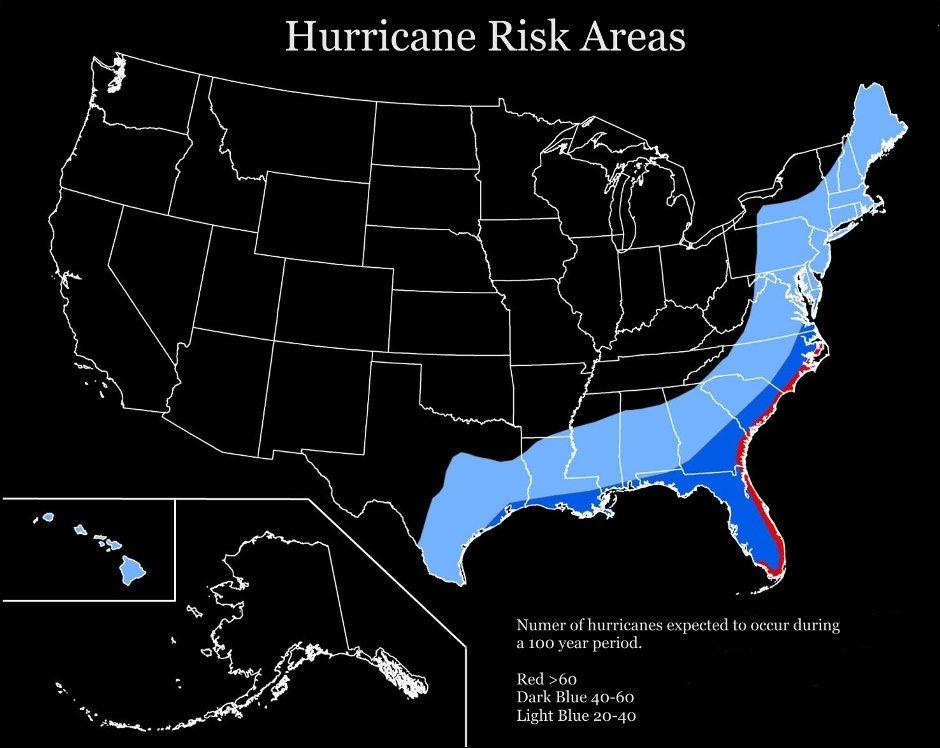All Atlantic and Gulf of Mexico coastal areas are subject to hurricanes. Parts of the Southwest United States and the Pacific Coast also experience heavy rains and floods each year from hurricanes spawned off Mexico. The Atlantic hurricane season lasts from June to November, with the peak season from mid-August to late October. The Eastern Pacific hurricane season begins May 15 and ends November 30.
Hurricanes can cause catastrophic damage to coastlines and several hundred miles inland. Hurricane can produce tornadoes and mircrobursts. Additionally, hurricanes can create storm surges along the coast and cause extensive damage from heavy rainfall. Floods and flying debris from the excessive winds are often the deadly and destructive results of these weather events. Slow moving hurricanes traveling into mountainous regions tend to produce especially heavy rain. Excessive rain can trigger landslides or mud slides. Flash flooding can occur due to intense rainfall.
Storm Surge has the greatest potential for loss of life related to a hurricane. Storm surge is simply water that is pushed toward the shore by the force of the winds swirling around the storm. This advancing surge combines with the normal tides to create the hurricane storm tide, which can increase the mean water level to heights impacting roads, homes and other critical infrastructure. In addition, wind driven waves are superimposed on the storm tide. This rise in water level can cause severe flooding in coastal areas, particularly when the storm tide coincides with the normal high tides. Because much of the United States' densely populated Atlantic and Gulf Coast coastlines lie less than 10 feet above mean sea level, the danger from storm tides is tremendous.
Terminology:
- Tropical Depression - An organized system of clouds and thunderstorms with a defined surface circulation and maximum sustained winds of 38 MPH or less. Sustained winds are defined as one-minute average wind measured at about 33 ft above the surface.
- Tropical Storm - An organized system of strong thunderstorms with a defined surface circulation and maximum sustained winds of 39-73 MPH.
- Storm Surge - A dome of water pushed onshore by hurricane and tropical storm winds. Storm surges can reach 25 feet high and be 50-1000 miles wide.
- Storm Tide - A combination of storm surge and the normal tide (i.e., a 15-foot storm surge combined with a 2-foot normal high tide over the mean sea level created a 17-foot storm tide).
- Hurricane/Tropical Storm Watch - Hurricane/tropical storm conditions are possible in the specified area, usually within 36 hours. Tune in to NOAA Weather Radio, commercial radio, or television for information.
- Hurricane/Tropical Storm Warning - Hurricane/tropical storm conditions are expected in the specified area, usually within 24 hours.
Saffir-Simpson Hurricane Wind Scale Summary
| Category | Sustained Winds | Damage |
| 1 | 74-95 MPH | Very dangerous winds will produce some damage
|
| 2 | 96-110 MPH | Extremely dangerous winds will cause extensive damage
|
| 3 | 111-130 MPH | Devastating damage will occur
|
| 4 | 131-155 MPH | Catastrophic damage will occur
|
| 5 | More than 155 MPH | Catastrophic damage will occur
|

